#python datatypes
Explore tagged Tumblr posts
Text

python int()class - Binary-Octal-Hexadecimal-Decimal also integer Datatypes
#python list class#python datatypes#python training in guntur#python training hyderabad#python jobs hyderabad#django jobs hyderabad#flask training hyderabad
1 note
·
View note
Note
hi. i had a very similar experince to trying to look through the code camp scams and everything online and not living near anything useful. if you can find an online real college thats what i did, granted its a community college and an associates but. other than that, don't sleep on utilizing chatgpt to teach you. thats how i learn all of my material. you can ask it questions or say "can you teach me about x", and if you dont like its response you can say things like "make that more simple" or "make that interactive". but helpful tip, all programming languages basically do the same things and work in very, very similar ways. if you just learn the fundamentals of programming you can just translate that to any language. in my opinion, the basics to learn are: the structures of programming (sequential, conditional, iterative), variables, datatypes (integer, string, float, etc)(in python those are it), conditional statements(these are those if-else things you see), iterative aka loops(do..while, for x in list, do until, etc), functions(keep em one purpose), passing data. i would say these are the fundamentals. every language does it (besides html bc thats not a programming language but just a mark up language), so once you know about the conditonal structure for example, just find out "how do i use this in x language". if you are learning python now, its a great language to learn about programming and you've probably realized by now that people most often use it in an object oriented way, but you don't have to and don't have to learn about classes or objects if you don't have the fundamentals down yet. i hope this helps and if you have any questions feel free to ask me

Oh I 100% agree with this advice. After looking for a long, long time, I realised the most legitimate courses were from 'real' colleges and education suppliers that offered 'brick n mortar' schooling as well as e-learning.
I'm definitely going to utilise the free resources online and then work towards building a profile and generally seeing what the jobs online look for and work towards that alongside the usual path of learning :)
Also, I love how supportive folk generally are in this area of learning. I knew it would be competitive, especially when it comes to getting a job in a year or so...but seeing folk lift each other up instead of put each other down is heart-warming on so many levels. It makes me think I've found my correct career path :)
#codeblr#supportive#thank you#advice#solid advice#good advice#lovely ask#thank you friend!#I love codeblr#programming#learning to code#learning programming#python#web development#coding
24 notes
·
View notes
Text
dreamdoll watchlist ★
youtube
key takeaways:
python is a good beginning coding language to start with
start with: variables, datatypes, loops, functions, if statements, oop
if you covered the basics, it would and should take you approx. 2 weeks.
first project: do something interesting/useful. start small.
simple games or a food recommendation system with specific ingredients
panda dataframe
use API = application programming interface = different pieces of software interacting with each other. grabbing data from another source
after your first project, learn about data structures and algorithms. how API works. learn how to read documentation.
dictionary
linkedlists
queues
heaps
trees
graphs
learn about more things and how to implement them into projects.
correct mindset:
implementation and application > theory and concepts knowing ≠ being able to do it
stay curious.
explore things outside of what is prescribed in a resource. that's how you learn about different concepts and how you deeply understand the concepts that you already know.
the best programmers they've met are the tinkers. these are the people who play around with their code and try a bunch of different things.
getting stuck:
it all comes down to problem solving. be comfortable with not knowing things and staying calm while trying to figure out the problems
how to learn even faster:
find a community where you work on projects together. you will learn so many things from other experiences programmers just by interacting with them. and accountability because you just can't give up
learning is never ending. you will always be learning something new.
12 notes
·
View notes
Text
DatatypeIn Python, a datatype is a classification that specifies which type of value a variable can hold. The use of datatypes in Python is crucial for defining the kind of data a variable can store and for determining the operations that can be performed on it. Here are some key aspects related to datatypes in Python
2 notes
·
View notes
Text
Immediate Matrix: Your Guide to Smart Trading Decisions

Trading, whether it's stocks or cryptocurrencies, has become a popular way for many people to make money. A new platform called Immediate Matrix says that its many features make it one of the best choices for traders who want to possibly make a lot of money. Some people who have only recently heard of the app may not know if it is real, though. To help you with this, we will carefully look over Immediate Matrix and rate every part of the platform to get a sense of how real it is as a trade platform.
✅ Trading App Name ╰┈➤ Immediate Matrix ⭐
✅ Offer Type ╰┈➤ Crypto ₿
✅ Traffic Cap ╰┈➤ N/A ❌
✅ Target Market ╰┈➤ Male and Female- 18-60+ years 👨🏼🤝👨🏻
✅ Investment ╰┈➤ $250 First Deposit 💰
✅ Fee ╰┈➤ No 🙅♂️
꧁༺✨❗Buy Now ❗✨༻꧂
https://www.offerplox.com/get-Immediate-Matrix
꧁༺✨❗ Official Facebook ❗✨༻꧂
https://www.facebook.com/groups/theimmediatematrix
꧁༺✨❗Shop Now ❗✨༻꧂
https://immediatematrix.company.site/
What Is Immediate Matrix?
Arrays, datatypes, and stored procedure snowflakes are used by this program to make trade execution more efficient. Price gaps or margins can be used to get or suggest order types with little risk. This is the idea behind the technology. What does it all mean? In simple words, it means that the technology that runs Immediate Matrix makes the things that happen behind the scenes faster and better.
💰 Click Here To Trade With Immediate Matrix For Free 🤑
All of this is done to raise the success rate so that members can get more benefits. Also, it's important to note that Immediate Matrix uses Python, Lisp, and Julia code. That being said, these programming languages, along with JavaScript and C++, are the most widely linked to AI development. Furthermore, AI sequence methods are used in real time for predictive analysis, along with formulas from combinatorial mathematics.
How Does Immediate Matrix Work?
Many people are interested in the Immediate Matrix Reviews because it has many analytical tools that can help users make important trading decisions that could lead to lucrative chances. There isn't much to talk about when it comes to how the platform works since the project doesn't include a trading robot or other features that make dealing easier for users.
We also couldn't find any details about the software and algorithms that were used to make the trading platform. In fact, buyers who sign up as users are the only ones who can even get to the dashboard that the website talks about. The platform's signup process seems to be as easy as it gets, since there is no Know Your Customer (KYC) step.
The trading charts, indicators, and other similar tools, on the other hand, look like they were made by the people who made the program and not by someone else. This means that users will be able to reach a platform that is better tailored to their needs.
Who Created Immediate Matrix?
As we looked into the platform, we found on a number of outside websites that the Immediate Matrix platform was created by a group of well-known and powerful people in the banking and blockchain industries. We did not find any proof, though, that such a group was behind the project. It looks like the developers decided to stay anonymous, which is common in the cryptocurrency world these days.
Immediate Matrix Features
Here are some of the most important parts of the Immediate Matrix program. The app is very far ahead of its time in the crypto space thanks to these abilities.
💰 Click Here To Trade With Immediate Matrix For Free 🤑
Strategy Tester
The Immediate Matrix Platform has a built-in strategy tester that lets traders test their favorite trading methods both in the past and in the future. Crypto traders can use the strategy tester tool to make their trading strategies better after setting their own preferences.
Demo Trading
Traders can use the demo account that comes with this advanced trading tool to try and improve their trading strategies before using it to trade with real money. People who trade on demo accounts can also learn how Immediate Matrix works.
High Customization
There are a lot of ways to change the Immediate Matrix program so that traders can have full control over their trading. Traders and buyers can change things about trading, such as the coins that can be traded, the amount staked, the trading times, the stop loss and take profit levels, and more. There is also room to switch between automated and manual trade modes in Immediate Matrix.
Demo Account
All Immediate Matrix partner brokers give all traders and buyers a free demo account that they can use as much as they want. This means that traders can test how well the software works and improve their trading skills before putting money into it for good.
Advanced Strategy
The Immediate Matrix trading software uses both advanced technical and fundamental methods to make sure that trades in the cryptocurrency markets are always correct. The app uses built-in artificial intelligence (AI) to figure out how people feel about the crypto market as a whole so that traders can make money in both trending and non-trending situations.
Automated Software
Based on coded algorithms, this cutting-edge training software helps people deal on the cryptocurrency market. Because it is automatic, investors don't need to do anything. The software does have a manual trading mode, though, which lets traders handle their accounts and take charge of their trading.
Safety
Immediate Matrix Software makes sure that its traders are safe by using the best security standards. People who trade in Bitcoin and its partner brokers help keep their money and personal information safe at all times. Immediate Matrix cares very much about the safety and security of its buyers.
How To Use Immediate Matrix?
If you're still interested in the site after reading the review, here's how to start trading on Immediate Matrix:
💰 Click Here To Trade With Immediate Matrix For Free 🤑
Step 1 – Visit the Immediate Matrix Website
Go to the official Immediate Matrix website and start the signup process to get things going. Giving simple information like your name, email address, and phone number is usually what this means.
Step 2 – Make the Minimum Deposit
After setting up and verifying your account, it's time to make your first payment. Before you can get to the screen, you have to do this. Several payment methods, such as credit cards and e-wallets that are accepted, can be used to add money to your account.
Step 3 – Start Trading with Immediate Matrix
Now that the deposit is complete, you can look at the different cryptocurrencies, buy in one, and start trading on the platform.
How Is Immediate Matrix Different Than Other Trading Apps?
Immediate Matrix is a platform for trading and getting tips about cryptocurrencies. It lets users customize alerts and signals for different cryptocurrencies. Here are some things that might make the Immediate Matrix trade app stand out or be important features:
Customizable Alerts: Stay up to date on important changes in the bitcoin market.
User-Friendly Interface: means a system that is easy for new or inexperienced users to use.
Market Data Aggregation: Immediate Matrix collects market data from different coin exchanges and makes it available.
Portfolio Tracking: The app has tools for portfolio tracking that let users see how their trades are doing.
Real-Time Notifications: Immediate Matrix wants to send real-time alerts when certain conditions are met.
Is Immediate Matrix a Scam?
It's not easy to say for sure whether Immediate Matrix Registration is a scam or a real cryptocurrency trading site. Many people are worried about the platform because they can't find much information about it before they put money, which is not ideal.
It also doesn't look like there are any clear social media names or other ways to get in touch with the platform before you make the minimum deposit and sign up. Even though Immediate Matrix makes bold claims about what it can do, it doesn't quite back them up with solid proof.
💰 Click Here To Trade With Immediate Matrix For Free 🤑
It is hard to make a firm decision about the platform because there isn't enough solid information to compare it to. Taking all of this into account, people who want to use the Immediate Matrix platform should be very careful and carefully consider their choices before they start trading.
Immediate Matrix Cost, Investment & Estimated Profit
You can use the Immediate Matrix Trading App for free. Traders only need to sign up and wait for approval from the team before they can use their account. You need to put at least $250 into your account before you can start betting. There are no fees to transfer money, withdraw money, or use Immediate Matrix's broking services. So, the only cost you have to pay is the money you put in to start trading. If you trade wisely, you can later make huge gains.
Conclusion
We did everything we could to find and analyze all the information we could find about Immediate Matrix. Although it advertises itself as a promising trading tool, there isn't much proof to back up its claims. It is very hard to tell if Immediate Matrix Official Website is real because there isn't enough solid information and data available.
We also saw that the site didn't have many reviews or comments from trustworthy sources. Because of these things, we highly advise that all users be very careful and do a lot of research before they open an Immediate Matrix account to trade.
ImmediateMatrix
ImmediateMatrixReviews
ImmediateMatrixPlatform
ImmediateMatrixSoftware
ImmediateMatrixLogin
ImmediateMatrixOfficialWebsite
ImmediateMatrixRegistration
ImmediateMatrixTrading
ImmediateMatrixApp
ImmediateMatrix2024
ImmediateMatrixLegit
ImmediateMatrixScam
ImmediateMatrixInvestment
ImmediateMatrixReal
ImmediateMatrixWealth
ImmediateMatrixDetails
ImmediateMatrixPlatformReviews
1 note
·
View note
Text
OverflowError: Python int too large to convert to C long
A datatype with date format was tried to converted to an integer , but due to the size of the integer, there was an overflow error. ddate = df['dat'].astype('int') return arr.astype(dtype, copy=True) OverflowError: Python int too large to convert to C long try: ddate = df['dat'].astype('int') except OverflowError: ddate = df['dat'].astype('int64')
0 notes
Text
How ONNX Runtime is Evolving AI in Microsoft with Intel

With the goal of bringing AI features to devices, the Microsoft Office team has been working with Intel and ONNX Runtime for over five years to integrate AI capabilities into their array of productivity products. The extension of AI inference deployment from servers to Windows PCs enhances responsiveness, preserves data locally to protect privacy, and increases the versatility of AI tooling by removing the requirement for an internet connection. These advancements keep powering Office features like neural grammar checker, ink form identification, and text prediction.
What is ONNX Runtime
As a result of their extensive involvement and more than two decades of cooperation, Intel and Microsoft are working more quickly to integrate AI features into Microsoft Office for Windows platforms. The ONNX Runtime, which enables machine learning models to scale across various hardware configurations and operating systems, is partially responsible for this accomplishment. The ONNX runtime is continuously refined by Microsoft, Intel, and the open-source community. When used in this way, it enhances the efficiency of Microsoft Office AI models running on Intel platforms.
AI Generative
With ONNX Runtime, you can incorporate the power of large language models (LLMs) and generative artificial intelligence (AI) into your apps and services. State-of-the-art models for image synthesis, text generation, and other tasks can be used regardless of the language you develop in or the platform you need to run on.
ONNX Runtime Web
With a standard implementation, ONNX Runtime Web enables cross-platform portability for JavaScript developers to execute and apply machine learning models in browsers. Due to the elimination of the need to install extra libraries and drivers, this can streamline the distribution process.
ONNX Runtime Java
Using the same API as cloud-based inferencing, ONNX Runtime Mobile runs models on mobile devices. Swift, Objective-C, Java, Kotlin, JavaScript, C, and C++ developers can integrate AI to Android, iOS, react-native, and MAUI/Xamarin applications by using their preferred mobile language and development environment.
ONNX Runtime Optimization
Inference models from various source frameworks (PyTorch, Hugging Face, TensorFlow) may be efficiently solved by ONNX Runtime on various hardware and software stacks. In addition to supporting APIs in many languages (including Python, C++, C#, C, Java, and more), ONNX Runtime Inference leverages hardware accelerators and functions with web browsers, cloud servers, and edge and mobile devices.
Ensuring optimal on-device AI user experience necessitates ongoing hardware and software optimization, coordinated by seasoned AI-versed experts. The most recent ONNX Runtime capabilities are regularly added to Microsoft Office’s AI engine, guaranteeing optimal performance and seamless AI model execution on client devices.
Intel and Microsoft Office have used quantization, an accuracy-preserving technique for optimizing individual AI models to employ smaller datatypes. “Microsoft Office’s partnership with Intel on numerous inference projects has achieved notable reductions in memory consumption, enhanced performance, and increased parallelization all while maintaining accuracy by continuing to focus on our customers,” stated Joshua Burkholder, Principal Software Engineer of Microsoft’s Office AI Platform.
With the help of Intel’s DL Boost, a collection of specialized hardware instruction sets, this method reduces the on-device memory footprint, which in turn reduces latency. The ONNX Runtime has been tuned to work with Intel’s hybrid CPU design, which combines efficiency and performance cores. With Intel Thread Director, this is further enhanced by utilising machine learning to schedule activities on the appropriate core, guaranteeing that they cooperate to maximise performance-per-watt.
Furthermore, on-device AI support for Office web-based experiences is being provided by Intel and Microsoft in partnership. The ONNX Runtime Web makes this feasible by enabling AI feature support directly in web applications, like Microsoft Designer.
Balancing Cloud and On-device
With the advent of AI PCs, particularly those featuring the latest Intel Core Ultra processor, more workloads are being able to move from cloud-based systems to client devices. Combining CPU , GPU , and NPU , Intel Core Ultra processors offer complementary AI compute capabilities that, when combined with model and software optimizations, can be leveraged to provide optimal user experience.
Even while the AI PC opens up new possibilities for executing AI activities on client devices, it is necessary to assess each model separately to ascertain whether or not running locally makes sense. AI computation may take on a hybrid form in the future, with a large number of models running on client devices and additional cloud computing used for more complicated tasks. In order to aid with this, Intel AI PC development collaborates with the Office team to determine which use cases are most appropriate for customers using the Intel Core Ultra processor.
The foundation of Intel and Microsoft’s continued cooperation is a common goal of an AI experience optimized to span cloud and on-device with products such as AI PC. Future Intel processor generations will enhance the availability of client compute for AI workloads. As a result, Intel may anticipate that essential tools like Microsoft Office will be created to provide an excellent user experience by utilizing the finest client and cloud technologies.
Read more on govindhtech.com
#onnxruntime#evolvingai#microsoft#windowspcs#aimodel#aigenerative#machinelearning#Intel#ai#technology#technews#govindhtech#news#ONNXruntimweb#onnx
0 notes
Text
Best Data Science Courses in Mumbai

Data Science Courses in Mumbai
Begin your journey towards enhancing your Data Science career with our exclusive Data Science course in Mumbai. Our comprehensive Data Science training in Mumbai with placement assistance is designed to help you master Python, Tableau, Hadoop, and Spark. Furthermore, you'll have the opportunity to gain world-class training from industry leaders and master the most in-demand data science and machine learning skills.
Why Choose DeveLearn for Data Science Course in Mumbai?
📊 Comprehensive Curriculum: Dive deep into the world of data science with our cutting-edge curriculum, covering everything from Python programming to advanced machine learning.
👩🏫 Expert Instructors: Learn from seasoned data scientists who bring real-world insights to the classroom, ensuring you gain practical skills that matter in the industry.
💼 Career Assistance: Your success is our mission. We provide comprehensive data science training and job placement assistance to help you kickstart your data science career.
🤝 Network & Connect: Join a vibrant data science community in Mumbai. We host networking events, seminars, and workshops, putting you in touch with industry leaders.
🏆 Certification: Earn a prestigious certification upon completion, giving you a competitive edge in the job market.
Career Assistance: At our institute, we are dedicated to your success. We offer comprehensive both online & offline data science course in Mumbai with placement assistance to kickstart your data science career with confidence.
Data Science Course Curriculum
Python
A comprehensive program for beginners to become skilled developers, focusing on popular libraries like NumPy, Pandas, and Django, enabling practical data analysis and web development.
Introduction to Python
Basic Syntax, Operators
Datatypes
Conditional Statements
Loops
Functions and Recurrsion
Object Oriented Programming
File Handling
Exception Handling
Web Scrapping
Libraries
Database Connectivity
SQL
The SQL module equips beginners with fundamental skills for managing and querying relational databases, making it an excellent starting point for Data Science and Analyst jobs.
Introduction To Databases
Introduction To SQL
SQL Data Manipulation Language
SQL Data Definition Language
Filtering and Sorting Data
Grouping and Aggregating Data
Joining Tables
Subqueries
Set Operations
SQL Data Control Language
Transaction Control
SQL Triggers
SQL Views
Statistics & Machine Learning
Our top-tier center offers comprehensive statistics and machine learning courses, equipped with expert faculty, state-of-the-art facilities, and industry partnerships for real-world challenges.
Descriptive & Inferential Statistics
Probability Distribution
Confidence Interval
Hypothesis Testing
Machine Learning Introduction
Supervised & Unsupervised Machine Learning
Linear Regression & Logistic Regression
Decision Tree & Random forest
Bagging & Boosting
Clustering
Dimension reduction Technique
Recommendation Engine
Overfitting & Underfitting
Model Evaluation Techniques
Artificial Intelligence
The AI, Deep Learning, and NLP module takes your skills to the State of the Art, enabling you to program Deep Learning machines and NLP-like computers with expert guidance and easy-to-understand resources.
Introduction to Artificial Intelligence
Introduction to Deep Learning
Artificial Neural Network (ANN)
Convolution Neural Network (CNN)
Recurrent neural Network (RNN)
Long Short-Term Memory (LSTM)
Generative Adversarial Network (GAN)
Natural language Processing
Text Preprocessing
Named Entity Recognition
Sentiment Analysis
Text Summarisation
Data Science Course Certification
Demonstration of Skills and Knowledge
Our data science institute in Mumbai offers a comprehensive curriculum that covers cutting-edge tools and sought-after techniques such as Python, R-Programming, and more.
This course certification serves as a powerful credential, opening doors to a multitude of opportunities when strategically leveraged. Armed with proficiency in these skills, you'll be well-equipped to excel in your career in record time.
Industry Recognition and Credibility
Upon successful completion of the Masters Program in Data Science and Machine Learning course at our esteemed data science classes in Mumbai, you will receive a recognized Certification from DeveLearn.
This certification not only validates your expertise as a data professional but also jumpstarts your career or takes your existing one to new heights. It adds significant value to your professional profile and enhances your resume.
0 notes
Text
An Introduction to GeoPandas
GeoPandas is a powerful Python library that makes working with geospatial data in Python easier. It extends the datatypes used by pandas, the standard tool for manipulating data frames in Python, to allow spatial operations on geometric types. Key Concepts GeoPandas, as the name suggests, extends the popular data science library pandas by adding support for geospatial data. The core data…

View On WordPress
0 notes
Text
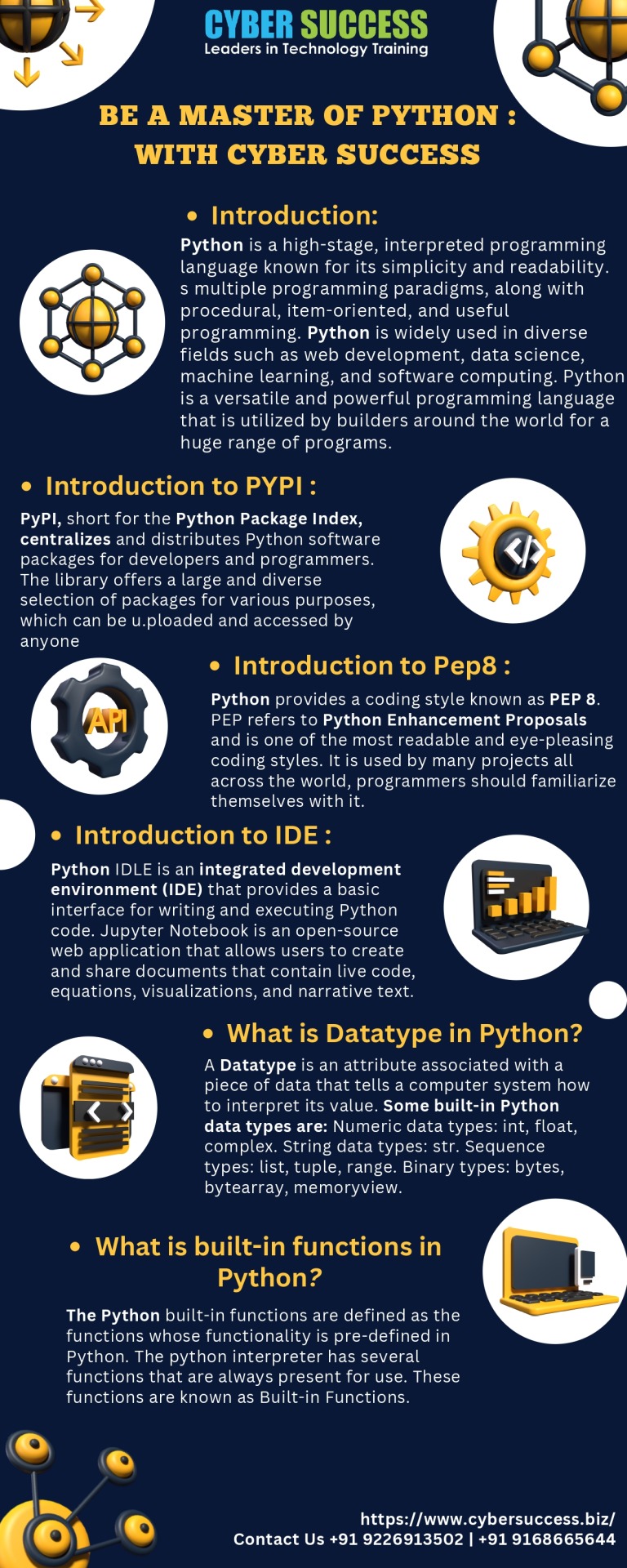
In today's technological world, Python is often used as a support language for software developers, for build control and management, testing, and in many other ways. Python is a high-level general programming language. It is an object-oriented programming language. Python is a high-stage, interpreted programming language known for its simplicity and readability.
In this infographic, you will learn the basic concepts of Python programming and also about some functions of Python like PYPI , Pep8, IDE, Datatype and more. At Cyber Success, whether you are an experienced software pro, new to coding, or just starting out in IT, our Python courses in Pune can open the door to exciting opportunities in this tech career in this case.
0 notes
Text
Python Unveiled: A Beginner's Odyssey into the World of Coding Magic
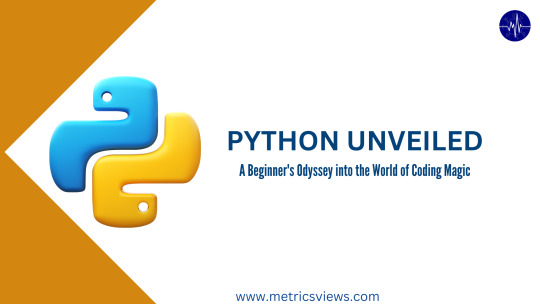
Installation:
Visit the official Python website: https://www.python.org/downloads/windows/
Click the appropriate link for your system to download the executable file: Windows installer (64-bit) or Windows installer (32-bit).
Run that downloaded executable installer file. For example, python.exe file.
Click Install to start the installation.
After the installation is complete, a Setup was successful message is displays.
To verify python installation:
Enter the code: python --version

Now you are ready to start learning and programming in Python.
Quick Summary:
Python has syntax that allows developers to write programs with less lines than some other programming languages. Python runs on an interpreter system. Python is a computer programming language often used to build websites and software, applications ,conduct data analysis.
Targeted Audience:
This article is intended for those people interested in learning the fundamentals of python development. It will be useful for freshers, backend developers, students. and for those who are lazy to write lengthy code because python has easy, simple syntax which includes short code.
Use Cases:
Web development -framework: Django, Flask, FastAPI, etc.
Data analysis - Pandas, NumPy
Game development - Pygame
Education and teaching programming concepts
Let’s see what Python is:
Definition:
Python is a high-level, general-purpose, interpreted object-oriented programming language and it is used to build websites and software.
Python code tends to be short and when compared to compiled languages like C and C++, it executes programs slower.
Features:
Easy to Learn and Use:
Python is easy to learn and simple as compared to other languages. Its syntax is straightforward.
There is no use of the semicolon or curly-bracket in syntax.
It is the most suggested programming language for beginners.
Interpreted Language:
Interpreted means program executes single line at a time.
The advantage of being interpreted language, makes it debugging easy and portable.
Expressive Language:
For Ex.: If you want to print small program you simply type print ("Hello World"). It will take only single line to execute, while Java or C takes multiple lines.
Free and Open Source:
Python is freely available for everyone. open-source means, "Anyone can download its source code without paying a single rupee.
Object-Oriented Language:
Python supports object-oriented language and concepts of classes and objects. It supports inheritance, polymorphism, and encapsulation, etc.
Syntax:
demo.py :- File name

How to run python file:
python myfile.py // here my myfile is name of program.

Python Comments:
Comments are often used to explain Python code. "#" used for commenting.
For Ex: # Printing hello world

Variables:
Variables are like containers it stores data values.
For Ex: x = 5 //x is a variable

Data Types:
String: In String datatype, we can store string values.

int: In int datatype, we can store int values.

float: In float datatype, we can store float values.

list: lists are always stored in square brackets [ ] .

tuple: tuples are always stored in round brackets ( ) .

dict: In Dictionaries, we store key value pair.

Function:
A function is a reusable block of code that performs some specific tasks. it only runs when it is called.
You can pass data, known as parameters in a function.
here : demo_function is function name. It can be anything.

Arrays:
Arrays are used to store multiple values but with same datatype.

To check length of an array
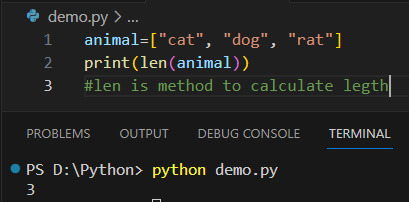
To add elements in array we use append method. For ex.: animal.append("fox")
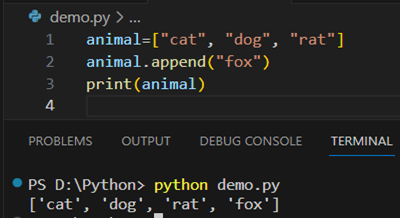
To delete elements in array we use pop method. it deleteindex wise.For Ex:animal.pop(1)
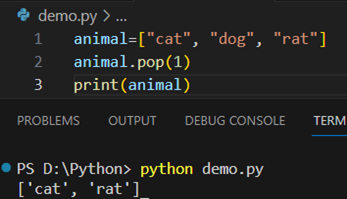
Removes all the elements from the list. Method:- clear()

Returns the number of elements with the specific value. Method: count()
It will return index value of 4 that is 1.
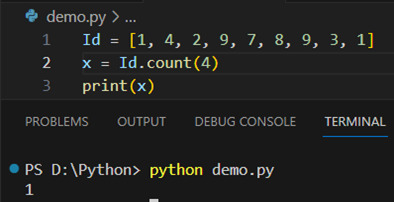
Adds an element at the specified position.Method:- insert()

Removes the first item with the given value. Method: remove()

Reverses the order of the list. Method: reverse()

Sorts the list. Method: sort()

Class:
Class is a blueprint of an object.
It defines the structure and behavior of objects of that class.
The class keyword is used to define a class.
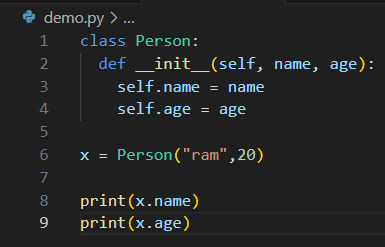
Object:
An object is an instance of a class and a collection of attributes and methods.
For ex.: x = Person("ram", 20)

Inheritance:
Inheritance is a OOP concept that allows you to create a new class based on an existing class. The new class inherits attributes and methods from the existing class, which is referred to as the base or parent class. The newer class is called the derived or child class of the base class.

Polymorphism:
polymorphism means having many forms.
Method Overloading (Compile-Time Polymorphism):
having same name but different parameters.
Method Overriding (Run-Time Polymorphism):
having same name and same parameters.
Encapsulation:
simple lang. wrapping or hiding of data.
object has ability to hide data and behavior that is not necessary to use.
How to take User Input: For ex.
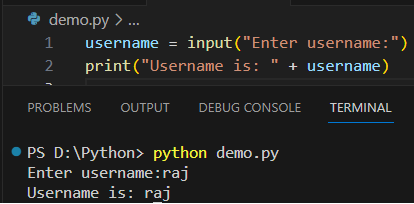
Closing Thought:
Python is a powerful and versatile programming language that has become an integral part of the technology. Everyone is using Python because of its simple syntax, and if you are a beginner, you should definitely go with python.
Credit – Priyanka Divekar
MetricsViews Pvt. Ltd.
MetricsViews specializes in building a solid DevOps strategy with cloud-native including AWS, GCP, Azure, Salesforce, and many more. We excel in microservice adoption, CI/CD, Orchestration, and Provisioning of Infrastructure - with Smart DevOps tools like Terraform, and CloudFormation on the cloud.
www.metricsviews.com.
0 notes
Text
"Python Data Types: Your Path to Enhanced Coding"
Get ready for an exciting journey! We're about to set out on an exploration into the foundational knowledge you need in the world of Python. Python is an incredibly versatile programming language that is used in various industries and can open the door for you to become a skilled coder. Without any more delay, let's start our exploration of the essential concepts that will empower you to excel in Python.
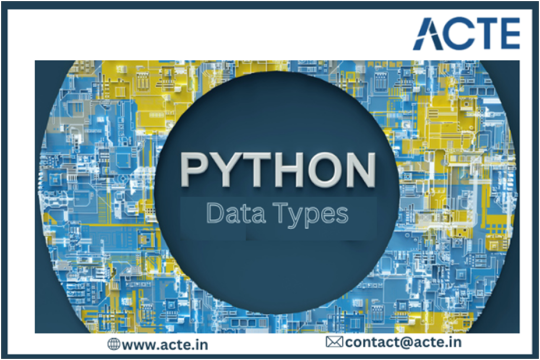
Python data types are the classification or categorization of data items. It represents the kind of value that tells what operations can be performed on a particular data. Since everything is an object in Python Programming, data types are actually classes and variables are instances (object) of these classes. The following are the standard or built-in data types in Python
Numeric
Dictionary
Boolean
Set
Sequence Type
Let’s Explore Deeper Into Each Data Type in Python:
Numeric Data Types:
Numeric data types are used to deal with all types of numerical data packets i.e. integer, float etc.Numeric data types are further divided into 3 types, which are
Integer.
Float.
Complex Number.
Integer in Python:
Integer (int) data type only holds integer numbers, it could be positive or negative.
We can't save decimal numbers in integer data type.
Here's a declaration of a variable x and it is assigned a value a of integer 20:
x = int(20)
Float in Python:
Float data types are used to hold decimal numerical values i.e. 2.13, 3.14 etc.
We can also save whole numbers in float data types.
Here's a declaration of a variable x and it is assigned a value a of float 20.5:
x = float(20.5)
Complex Numbers in Python:
Complex Number data types is used to keep complex numbers in it. Complex numbers are those numerical values which have real & imaginary part.
That's the versatility of python language, I haven't seen complex number data type in any other programming language.
Here's a declaration of a variable x and it is assigned a complex number 1+3j:
x = complex(1+3j)
2. Dictionary (dict):
A dictionary in Python is an unordered collection of data values, used to store data values like a map, unlike other Data Types that hold only a single value as an element, a Dictionary holds a key: value pair.
Key-value is provided in the dictionary to make it more optimized.
Each key-value pair in a Dictionary is separated by a colon : , whereas each key is separated by a ‘comma’.
In Python, a Dictionary can be created by placing a sequence of elements within curly {} braces, separated by ‘comma’.
Values in a dictionary can be of any datatype and can be duplicated, whereas keys can’t be repeated and must be immutable.
The dictionary can also be created by the built-in function dict(). An empty dictionary can be created by just placing it in curly braces{}.
Here's a declaration of a variable x and it's assigned a dictionary data type:
x = dict(name="John", age=36)

3. Boolean (bool):
Data type with one of the two built-in values, True or False.
Boolean objects that are equal to True are truthy (true), and those equal to False are falsy (false). But non-Boolean objects can be evaluated in a Boolean context as well and determined to be true or false.
It is denoted by the class bool.
Here's a declaration of a variable x, assigned a Boolean data type and it's TRUE:
x = bool(1)
4. Set Data Types:
In Python, a Set is an unordered collection of data types that is iterable, mutable and has no duplicate elements.
The order of elements in a set is undefined though it may consist of various elements.
Sets can be created by using the built-in set() function with an iterable object or a sequence by placing the sequence inside curly braces, separated by a ‘comma’.
The type of elements in a set need not be the same, various mixed-up data type values can also be passed to the set.
5. Sequence Data Types:
Sequence Type data types are used to save data in characters form.
We can't save numerical data in sequence type but we can convert the two. ( We will discuss that later )
Sequence Types are further divided into 3 types, which are
String.
List.
Tuple.
String (str):
Strings are used to represent sequences of characters, like words, sentences, or text. They are crucial for text manipulation, string formatting, and working with textual data.
Strings in Python are arrays of bytes representing Unicode characters.
A string is a collection of one or more characters put in a single quote, double-quote, or triple-quote.
In python there is no character data type, a character is a string of length one.
It is represented by str class.
Example:x = "Hello, World"
List (list):
Lists are ordered collections of items.
They can store elements of different data types and are mutable, which means you can add, remove, or modify elements in the list.
Lists are versatile and used for various data storage and manipulation tasks.
Example:x = ["apple", "banana", "cherry"]
Tuple (tuple):
Just like a list, a tuple is also an ordered collection of Python objects.
The only difference between a tuple and a list is that tuples are immutable i.e. tuples cannot be modified after it is created. It is represented by a tuple class.
In Python, tuples are created by placing a sequence of values separated by a ‘comma’ with or without the use of parentheses for grouping the data sequence.
Tuples can contain any number of elements and of any datatype (like strings, integers, lists, etc.).
Having one element in the parentheses is not sufficient, there must be a trailing ‘comma’ to make it a tuple.
Tuples are similar to lists but are immutable, which means you cannot change their content once defined. Tuples are used when you need to ensure that the data remains constant.
Example:
x = ("apple", "banana", "cherry")
These data types are the building blocks of Python programming. As you gain more experience with Python, you'll use these data types extensively to work with a wide range of data and solve various programming problems.
For those looking to expand their Python knowledge, ACTE Technologies is worth exploring. Their instructors are highly skilled and proficient in teaching Python. Whether you prefer online or in-person learning, they offer flexibility in your choice of learning environment. Python program at ACTE Technologies includes certification options and support in finding job placements.
0 notes
Text
Python Data Types
Every value has a datatype, and variables can hold values. Python is a powerfully composed language; consequently, we don't have to characterize the sort of variable while announcing it. The interpreter binds the value implicitly to its type.

0 notes
Text
Yeah, double precision floating point (the default on most 64-bit machines) only has 52 significant bits (~16 significant digits). Big-Integer or other non-floating-point based datatypes can store arbitrary precision, usually at the cost of speed (due to having to implement algorithms like basic arithmetic in software rather than in hardware). In this case, the scipy code specifically initializes the resulting polynomial with a floating point datatype; but the algorithm still works fine with a non-floating point datatype.
I rewrote the function to use python's built-in Fraction type. The algorithm is O(n^3) (experimentally more like n^3.5) so the interpolation takes a while to generate for larger datasets, but not terribly long. For 225 datapoints it took almost a minute to compute, and the largest denominator has 429 digits; for 350 it took 326 seconds (a little over 5 minutes; still reasonable) and the largest denominator has 737 digits.
on github here:
and the results:

I was messing around with some data plotting and it seems like none of the python tools will actually plot a 350-degree polynomial fit.
Like I know that plotting a 350-degree polynomial fit is dumb. I'm an educator. I want a graph showing exactly why plotting a 350-degree polynomial fit is dumb, but that requires me to actually get the equation of the 350-degree polynomial fit.
And like calculating the Lagrange polynomial is straightforward. I know a couple ways to do it. But I don't want to have to roll my own code when in theory there are libraries for this.
203 notes
·
View notes